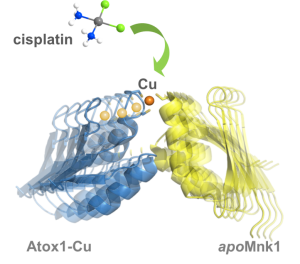Mechanistic and structural basis for inhibition of copper trafficking by platinum anticancer drugs
 Only a few percent of the platinum (Pt)-based anticancer drugs reaches the nucleus and binds to DNA. The remaining part can interfere with copper (Cu) homeostasis and mediate cytotoxicity or resistance to chemotherapy. A study recently published in the prestigious Journal of the American Chemical Society has revealed the structural mechanisms underlying the interaction between Pt drugs and two proteins involved in Cu trafficking (the metallochaperone Atox1 and the first domain of Menkes ATPase, Mnk1). Using X-ray diffraction, it was possible to determine the atomic structure of the two proteins in the act of interacting simultaneously with a Cu ion and the Pt drug. Overall, crystallographic and nuclear magnetic resonance investigations demonstrated that the anticancer drugs cisplatin and oxaliplatin can interfere with the rapid exchange of Cu between Atox1 and Mnk1, with possible consequences on cancer cell viability and migration. The study, conducted in collaboration between the Institute of Crystallography (Dr. Caliandro’s group) and the University of Bari (Prof. Arnesano’s group), was highlighted in the cover of the latest issue of the journal.
Only a few percent of the platinum (Pt)-based anticancer drugs reaches the nucleus and binds to DNA. The remaining part can interfere with copper (Cu) homeostasis and mediate cytotoxicity or resistance to chemotherapy. A study recently published in the prestigious Journal of the American Chemical Society has revealed the structural mechanisms underlying the interaction between Pt drugs and two proteins involved in Cu trafficking (the metallochaperone Atox1 and the first domain of Menkes ATPase, Mnk1). Using X-ray diffraction, it was possible to determine the atomic structure of the two proteins in the act of interacting simultaneously with a Cu ion and the Pt drug. Overall, crystallographic and nuclear magnetic resonance investigations demonstrated that the anticancer drugs cisplatin and oxaliplatin can interfere with the rapid exchange of Cu between Atox1 and Mnk1, with possible consequences on cancer cell viability and migration. The study, conducted in collaboration between the Institute of Crystallography (Dr. Caliandro’s group) and the University of Bari (Prof. Arnesano’s group), was highlighted in the cover of the latest issue of the journal.
Lasorsa A., Nardella M.I., Rosato A., Mirabelli V., Caliandro R., Caliandro R., Natile G., Arnesano F. “Mechanistic and Structural Basis for Inhibition of Copper Trafficking by Platinum Anticancer Drugs” J. Am. Chem. Soc. 2019, 141, 12109−12120. DOI: 10.1021/jacs.9b05550.
